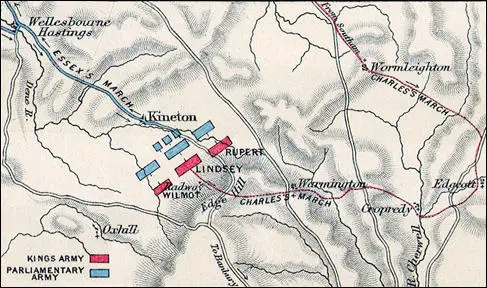Battle of Edgehill
On the outbreak of the English Civil War King Charles I marched around the Midlands enlisting support before marching on London. It is estimated he had about 14,000 followers by the time he encountered the Parliamentary Army at Edgehill on 22nd October, 1642. Robert Devereux, the Earl of Essex, only had 3,000 cavalry against the 4,000, serving the king. He therefore decided to wait until the rest of his troops, who were a day's march behind, arrived. (1)
The battle began at 3 o'clock in the afternoon of the 23rd October. Prince Rupert and his Cavaliers made the first attack and easily defeated the left-wing of the Parliamentary forces. Henry Wilmot also had success on the right-wing but Sir Philip Stapleton and Oliver Cromwell were eventually able to repel the attack. Colonel Nathaniel Fiennes, later recalled that Cromwell "never stirred from his troops" and fought until the Cavaliers retreated. (2)

Prince Rupert's cavalrymen lacked discipline and continued to follow those who ran from the battlefield. John Byron and his regiment also joined the chase. The royalist calvary did not return to the battlefield until over an hour after the initial charge. By this time the horses were so tired they were unable to mount another attack against the Roundheads. The fighting ended at nightfall. Neither side had one a decisive advantage. (3) A pamplet published at the time commented: "The field was covered with the dead, yet no one could tell to what party they belonged... Some on both sides did extremely well, and others did ill and deserved to be hanged." (4)
The Earl of Essex decided to withdraw his men to Warwick. This left the Royalists free to march on London. Prince Rupert was all for a swift advance on the capital, but the King, shocked by the slaughter he had witnessed, moved only slowly south-east before deciding to make his way to Oxford, which became his headquarters for the duration of the war. (5)
Primary Sources
(1) Eyewitness account of the footsoldiers that fought in the royalist army at the Battle of Edgehill on 23 October, 1642.
Arms were the great deficiency, and the men stood up in the same garments in which they left their native fields; and with scythes, pitchforks, and even sickles in their hands, they cheerfully took the field, and literally like reapers descended to the harvest of death.
(2) Edmund Verney, royalist officer, letter to his son before the Battle of Edgehill (October, 1642)
Our men are very raw, our victuals scarce and provisions for horses worse. I daresay there was never so raw, so unskilful and so unwilling an army brought to fight.
(3) A pamphlet An Exact and True Relation of a Dangerous and Bloody Fight near Kineton, was published soon after the Battle of Edgehill (October, 1642)
The field was covered with the dead, yet no one could tell to what party they belonged... Some on both sides did extremely well, and others did ill and deserved to be hanged.
(4) Earl of Clarendon, The History of the Rebellion (1667)
At Edgehill... the foot soldiers stood their ground with great courage; and though many of the King's soldiers were unarmed and had only cudgels, they kept their ranks, and took up the arms which their slaughtered neighbours left to them.
Student Activities
Military Tactics in the Civil War (Answer Commentary)
